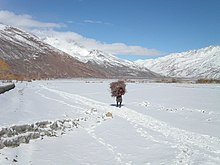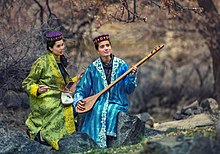Ethnic group
 A Wakhi girl photographed near the village of Zood Khun in the Chapursan Valley of Gilgit−Baltistan, Pakistan A Wakhi girl photographed near the village of Zood Khun in the Chapursan Valley of Gilgit−Baltistan, Pakistan | |
| Total population | |
|---|---|
| Unknown | |
| Languages | |
| Wakhi | |
| Religion | |
| Predominantly Islam (Isma'ili Shia) | |
| Related ethnic groups | |
| Other Iranian peoples |
The Wakhi people (Wakhi: ښیک مردمِش, Shughni: Waxiēn, Persian: مردمان وخی; Russian: Ваханцы; Chinese: 瓦汗 or 瓦罕), also locally referred to as the Wokhik (وخیک), are an Iranian ethnic group native to Central and South Asia. They are found in Afghanistan, Tajikistan, Pakistan, and China—primarily situated in and around Afghanistan's Wakhan Corridor, the northernmost part of Pakistan's Gilgit−Baltistan and Chitral, Tajikistan's Gorno−Badakhshan Autonomous Region and the southwestern areas of China's Xinjiang Uyghur Autonomous Region. The Wakhi people are native speakers of the Wakhi language, an Eastern Iranian language.
Name
The Wakhi people refer to themselves as Khik and to their language as Khik zik. The exonym Wakhī, which is given to them by their neighbours, is based on Wux̌, the local name of the region of Wakhan, deriving from *Waxšu, the old name of the Oxus River (Amu Darya), which is a major river formed by the junction of the Vakhsh and Panj rivers on the border between Tajikistan and Afghanistan.
Demographics


Their population is divided between four countries: Afghanistan, Tajikistan, Pakistan and China's Xinjiang. The Wakhi people have been settlers of their lands for hundreds if not thousands of years. The machinations of The Great Game during the eighteenth and nineteenth century created boundaries which separated the large body of the Wakhis into living in four countries.
In Tajikistan, Wakhi are inhabitants of Roshtqal'a District and Ishkoshim District of Gorno-Badakhshan Autonomous Region.
In Afghanistan, Wakhi primarily live in the Wakhan District of Badakhshan Province.
In Gilgit-Baltistan in the north of Pakistan, Wakhi predominantly live in the upper region of Hunza popularly known as Gojal. Wakhi speakers also live in Ishkoman Valley of District Ghizer, and some villages of Yasin Valley.
In Pakistan, Wakhi also live in Broghal in Chitral district of Khyber Pakhtunkhwa province.
In China, Wakhi are inhabitants of Taxkorgan Tajik Autonomous County an administrative area within Kashgar Prefecture of Xinjiang, mainly in the township of Dafdar.
In China, the Wakhi people, together with the Sarikoli people, are officially recognized as "Tajiks", with ethnic-minority autonomous status. In Afghanistan, they are officially called "Pamiri". In Tajikistan, they are recognized by the state as "Tajiks", but self-identify as "Pamiri". In Pakistan, they refer to themselves as "Wakhi" or "Pamiri" or "Gujali".
The Wakhi predominantly adhere to Nizari Ismaili Shia Islam, which is regarded as their ethnic religion and are followers of the Aga Khan.
Economy
The Wakhi are primarily nomadic, depending on their herds of yaks and horses. They often have two residences—one for winter and one for summer. Their houses are built of stone and sod.
Cultural preservation
Activists and researchers have been working to preserve and record the language of the Wakhi people, and have developed Wakhi orthographies using the Arabic, Cyrillic, and Latin scripts.
In 1990, the Gojali Wakhis of Pakistan established the Wakhi Tajik Cultural Association to preserve, document, and publish their local culture. The association introduced a script that was applied into linguistic and literary textbooks, and organized cultural festivals. Radio Pakistan's Radio Gilgit also aired a daily Wakhi-language program named Bam-e Dunya ("Roof of the World").
See also
Notes and references
- ^ Kreutzmann, Hermann (3 September 2003). "Ethnic minorities and marginality in the Pamirian Knot: survival of Wakhi and Kirghiz in a harsh environment and global contexts". The Geographical Journal. 169 (3). Blackwell Publishing: 215–235. doi:10.1111/1475-4959.00086.
- ^ "Wakhi". Endangered Language Alliance. Retrieved 14 July 2018.
- "Iranian languages". Encyclopædia Britannica. Retrieved 14 July 2018.
- West, Barbara (2008). Encyclopedia of the Peoples of Asia and Oceania. Facts on File. ISBN 978-0816071098.
- Shahrani, M. Nazif Mohib (2002). The Kirghiz and Wakhi of Afghanistan. Seattle: University of Washington Press. p. 216. ISBN 0-295-98262-4.
- "Khyber Pakhtunkhwa: People and Tribes". Government of the Khyber Pakhtunkhwa. Archived from the original on 16 March 2015.
- Brower, Barbara; Johnston, Barbara Rose (2016). Disappearing Peoples?: Indigenous Groups and Ethnic Minorities in South and Central Asia. Routledge. p. 184. ISBN 9781315430393.
- Windfuhr, Gernot (2013). The Iranian Languages. Routledge. p. 826. ISBN 9781135797034.
Bibliography
- Felmy, Sabine (1996). The Voice of the Nightingale: A Personal Account of the Wakhi Culture in Hunza. New York: Oxford University Press. ISBN 0-19-577599-6.
- Shahrani, M. Nazif (1979). The Kirghiz and Wakhi of Afghanistan: Adaptation to Closed Frontiers and War. Seattle: University of Washington Press. ISBN 0-295-95669-0.; 1st paperback edition with new preface and epilogue (2002), ISBN 0-295-98262-4.
Further reading
- Gri︠u︡nberg, Aleksandr Leonovich; Steblin-Kamenskiĭ, I. M. (1988). La langue wakhi (in French). Vol. 1. Corpus de littérature orale. Les Editions de la MSH. ISBN 9782735102884.
External links
- "Photos From Afghanistan: Natural Beauty, Not War". NPR. 29 September 2010. (slideshow)
- "A small village in Gilgit-Baltistan is making big efforts to keep its music alive". Scroll.in. 8 November 2016.
- "About the Website – Fazal Amin Beg".
- "Gojal Hunza : diverse & tribal domains / Zafar Iqbal". upenn.edu.
| Ethnic groups in Afghanistan | |
|---|---|
| Ethnic groups | |
| Foreign nationals | |
| Ethnic groups in Pakistan | |||||||||||||||||
|---|---|---|---|---|---|---|---|---|---|---|---|---|---|---|---|---|---|
| |||||||||||||||||
| Ethnic groups in Tajikistan | |
|---|---|
| Iranian peoples | |
|---|---|
| Ethnic groups | |
| Related ethnic groups | |
| Ancient peoples | |
| Origin | |
| Languages | |
| Iranian religions | |